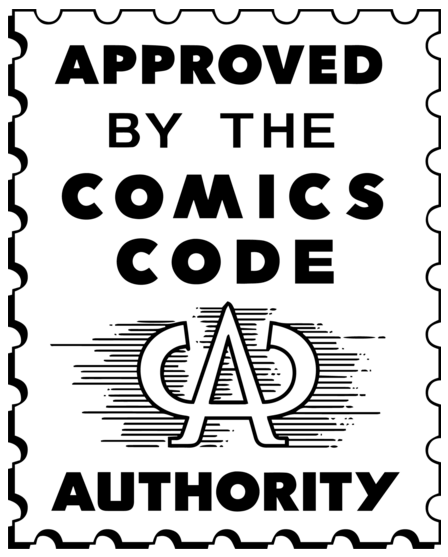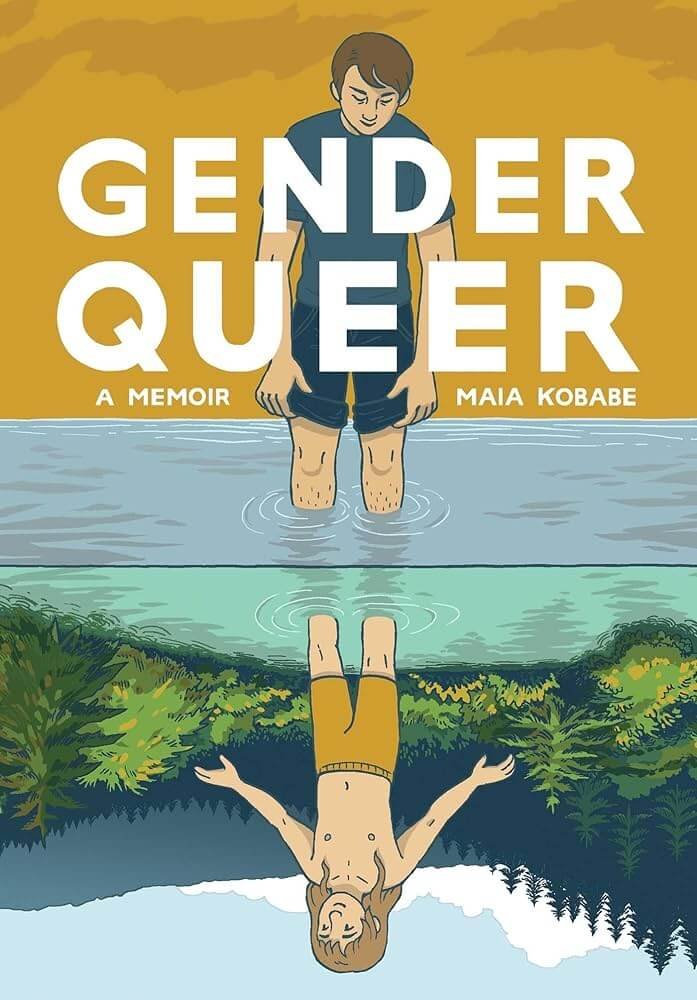Queer Superhero History: The Comics Code Authority
It’s time for another installment of Queer Superhero History, where we look back at queer characters in mainstream superhero comics, in (roughly) chronological order, to see how the landscape of LGBTQ+ rep in the genre has changed over time.
As you can probably tell from the title, this isn’t actually a character profile. But if we’re going to talk about queer representation in mainstream American comics, especially in the 20th century, we need to talk about the Comics Code Authority.
Comic books as we know them began in the 1930s, with superheroes in particular really taking off (get it?) during World War II. But after the war, comics were met with an increasing backlash from parents, teachers, religious figures (especially the Catholic Church), and other adults with authority over children. Comics were aimed at and read by most children, and there was a growing fear that they were causing a rise in juvenile delinquency.
The anti-comics backlash had two high (or low) points. The first was the 1954 publication of Seduction of the Innocent by Dr. Fredric Werthem, a psychiatrist who genuinely believed that comics caused children to become juvenile delinquents, and was perfectly willing to lie or cherry pick his findings to prove his case. The second was a series of congressional hearings, also in 1954 and at which Wertham testified, to determine whether comics were, in fact, harmful to children. These hearings did not go well for the comics industry. (Fun fact: they began on the same day as the McCarthy hearings, so, like…that’s the landscape we’re in here.)
The seal that appeared on thousands of comics between 1954 and 2010.
In response, the comics industry decided to self-regulate, much the way the film industry had a couple decades prior with the Hays Code. The Comics Code Authority was formed later that year. Publishers would submit their comics to the CCA, and if they met all the requirements of the Code, they would be allowed to publish with a seal on the cover that said “Approved by the Comics Code Authority.” You could absolutely publish a comic without CCA approval, but many retailers wouldn’t carry it if you did. So most publishers bent over backwards to comply.
I tend to think of the CCA’s prohibitions as falling into three categories:
1. “Yes, that’s about what I would expect”: No nudity, sex, drugs, and serious restrictions on violence.
2. “Okay that’s fascism”: No disrespecting authority figures such as parents, elected officials, police, and clergy; criminals can never be portrayed as sympathetic and must always be punished.
3. “Haha what?”: No zombies, werewolves, or vampires. (There are a number of places in the original Code text where it’s clear the other publishers were transparently trying to drive the very popular horror publisher EC Comics out of business. Sadly, they ultimately succeeded.)
But most important for the purposes of the Queer Superhero History series are these two items from the section on Marriage and Sex:
“(2) Illicit sex relations are neither to be hinted at nor portrayed. Violent love scenes as well as sexual abnormalities are unacceptable.
[...]
(7) Sex perversion or any inference to same is strictly forbidden.”
There is no explicit reference to homosexuality, queerness, or same-sex relations. But it was 1954, and “illicit sex relations,” “sexual abnormalities,” and “sex perversion” were clear enough.
(There’s also this item from the section on Costume: “(3) All characters shall be depicted in dress reasonably acceptable to society.” But Jimmy Olsen spent a decent amount of time crossdressing in the 60s, so I’m not sure how strongly this prohibition was taken. Most likely it was similar to the film industry: if it was for humor, it was okay.)
Now to be clear, it wasn’t as if comics had abounded with textual queerness prior to 1954. In the mid-40s, Wonder Woman’s co-creator William Moulton Marston had given her a home on the all-female Paradise Island, where the Amazons played…let’s say unsubtle games of “love and submission” that pretty much always included bondage. There may have been some winking subtext in the relationship between Batman and Robin, though certainly not as much as Wertham infamously accused them of. (He wrote: “They live in sumptuous quarters, with beautiful flowers in large vases, and have a butler. It is like a wish dream of two homosexuals living together.” You heard it here, folks: being rich is gay.) And like every form of pop culture, comics had the occasional drag gag.
William Moulton Marston, Wonder Woman’s co-creator, had…extremely distinct and unsubtle tastes. [Sensation Comics #35 (November 1944), art by H. G. Peter.]
But now queerness was explicitly forbidden. Any creator who wanted to reference it, positively or negatively, had to do so via coded language and art. Steps were taken to straighten out suggestively queer characters: Wonder Woman stopped spanking other women and started daydreaming about her boyfriend Steve Trevor proposing to her (the kinky, polyamorous Marston’s death in 1947 helped with these sanitizing efforts). Batman and Robin were given “love interests” in the form of Batwoman (Kathy Kane) and Bat-Girl (Betty Kane), although their aggressive contempt towards these women and constant attempts to avoid romantic entanglements do not today come across as resoundingly heterosexually as DC might have hoped. In superhero comics, the line between misogyny and homoeroticism is always razor-thin.
But after Stonewall, we started to see more subtext creeping back in, first subtly and then increasingly unmistakably. An intense friendship between supporting characters in Black Panther; a member of the Legion of Super-Heroes who was quietly not given a girlfriend in deference to queer fans’ interpretation of him. Captain America’s childhood best friend, who lived with his “roommate.” In 1983, an issue of Fantastic Four contained the first use of the word “gay” as a reference to sexuality, which was in direct violation of the Code—but that comic was still published with the CCA seal.
I’m not sure if John Byrne intended for Johnny’s timing here to be suggestive, but that boy is still suffocating in the closet 42 years later. And yes, that is a thinly veiled Christopher Reeve in the foreground. [Fantastic Four #251 (February 1983), art by John Byrne.]
By the late 80s, multiple creators (notably but not exclusively John Byrne and Chris Claremont) were including heavy coding in their work. In 1988, the first out queer superhero, Extraño, debuted in a DC comic.
In 1989, the Comics Code was heavily revised.
It wasn’t just about sexuality—after 35 years of major social upheaval, the Code was extremely out of date and many of its prohibitions were being ignored, especially the ones regarding skimpy costumes—but sexuality was addressed in the very first paragraph of guidelines (emphasis mine for all of the below quotes):
“INSTITUTIONS
In general recognizable national, social, political, cultural, ethnic and racial groups, religious institutions, law enforcement authorities will be portrayed in a positive light. These include the government on the national, state, and municiple [sic] levels, including all of its numerous departments, agencies and services; law enforcement agencies such as the FBI, the Secret Service, the CIA, etc.; the military, both United States and foreign; known religious organizations; ethnic advancement agencies; foreign leaders and representatives of other governments and national groups; and social groups identifiable by lifestyle, such as homosexuals, the economically disadvantaged, the economically privileged, the homeless, senior citizens, minors, etc.”
It’s still kind of fascist that you can’t say anything negative about the government (this was definitely not obeyed) and both funny and depressing that you can’t say anything negative about rich people.
The Code also states:
“References to physical handicaps, illnesses, ethnic backgrounds, sexual preferences, religious beliefs, and race, when presented in a derogatory manner for dramatic purposes, will be shown to be unacceptable.
[...]
Character portrayals will be carefully crafted and show sensitivity to national, ethnic, religious, sexual, political and socioeconomic orientations.
If it is dramatically appropriate for one character to demean another because of his or her sex, ethnicity, religion, sexual preference, political orientation, socioeconomic disadvantages should never assign ultimate responsibility for these conditions to the character themselves.”
In other words, queerness is now allowed but cannot be portrayed negatively, and superheroes are not allowed to be homophobic.
I don’t agree with censorship even when it’s censoring things I dislike, like homophobia, but at least characters could start coming out now. And they did: several at DC, and then finally Northstar at Marvel in 1992, with exponentially more queer characters at both companies every subsequent decade.
The CCA continued to weaken over the years. Several major books by both publishers, including Watchmen and The Dark Knight Returns (both DC), had been published without the seal; in 2001, Marvel stopped bothering with it entirely. In January 2011, DC and Archie, the only publishers still submitting their comics to the CCA, announced that they would no longer be doing so, effectively rendering it defunct.
Of course, as much as we might like to make the CCA out to be a bogeyman, it always reflected the cultural values and assumptions of its time: the original in 1954, the updates in 1971 and 1989. The death of the CCA doesn’t mean that there isn’t anyone at DC or Marvel going “But think of the children!” when it comes to queer rep in comics, even though superhero comics are mostly read by adults these days. (Or, more likely, “But think of the market value of our IP!”) It’s actually much harder to track that sort of quiet censorship, when the rules aren’t literally published for all to see.
Maia Kobabe’s memoir Gender Queer is one of the most challenged books of the 21st century.
It is also worth noting that today’s book banners often target comics, and for the same reasons they always have: it’s easy to grab an image out of context and declare it Bad For Children. Though today’s book banners are more much more focused on middle grade and young adult graphic novels than monthly superhero comics, the language they use now is nearly identical to the language they used 75 years ago, when comics were being tossed onto bonfires. This piece by Kelly Jensen, whose anti-book bans work you should be absolutely following, does a superb deep dive into comics burnings and how similar the tactics of 1950s censors were to today’s.
The Comics Code Authority can seem like a relic, but it offers a very clear blueprint for exactly how certain voices and experiences are silenced. I don’t know if the Code’s rules about sexuality were changed in 1989 because DC had put Extraño in a comic the year before and no one died, or what. But I know that just like in every other form of media, we have queer rep—and every other kind of rep—in comics because creators and fans continued to push for it even when it was forbidden, whether explicitly or implicitly. We owe it to them to know the history—and to fight as hard as they did for the future.
You can read the full text of the original Comics Code here and the 1989 update here. Kelly Jensen’s work can be found here. For more on the backlash that led to the formation of the Comics Code, The Ten-Cent Plague by David Hajdu is a fascinating read.



